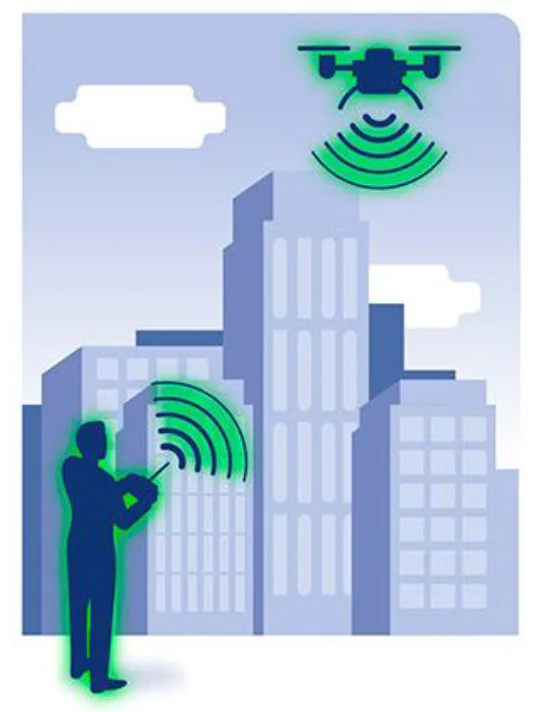MAKING URBAN DRONE PACKAGE DELIVERY A REALITY
Electric Variable Buoyancy Airships (eVBAs) For Urban Drone Last-Mile Delivery
Aeros redefines last-mile logistics with its groundbreaking Airborne Fulfillment Center (AFC) system. This innovative approach integrates advanced electric airship technology with drone delivery, ensuring faster, cost-effective, and zero-emission package distribution, setting a new benchmark for sustainable last-mile logistics.
In a world where convenience reigns supreme, Aeros introduces the first true airborne fulfillment system: the Electric Variable Buoyancy Airship (eVBA) hovers above cities as a mobile warehouse and drone hub. This approach can achieve a cost per package delivery as low as $1.50.
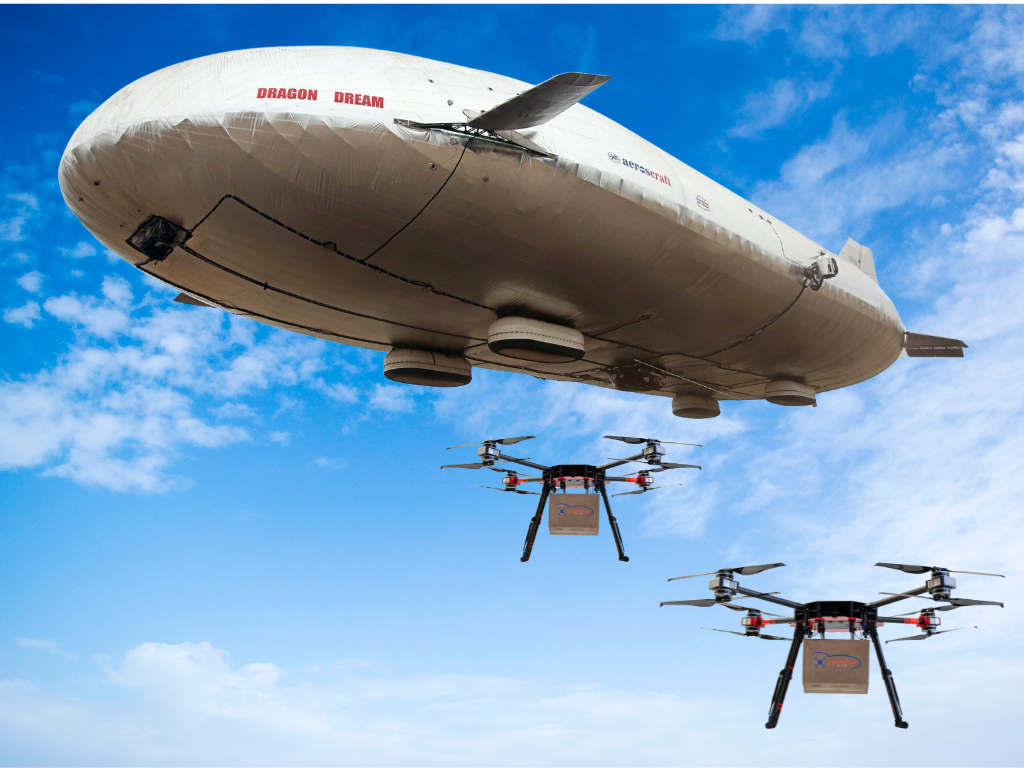
The eVBA deploys drones to deliver packages directly to customers’ doorsteps within 60 minutes, reducing dependency on ground infrastructure, expediting delivery times, and significantly minimizing environmental impact.
By combining advanced eVBA and drone technologies, it eliminates the need for delivery vans and complex ground operations. Drones “float” packages down from the eVBA and return for recharging for the next delivery, creating an efficient and seamless urban delivery system.
Positioning drone pilots on board our airship allows full compliance with FAA regulations for commercial drone package delivery in densely populated areas. This transformative solution will reshape urban delivery, offering speed and simplicity unmatched by traditional methods for online retailers, particularly those in the fashion, electronics, and consumer goods industries.
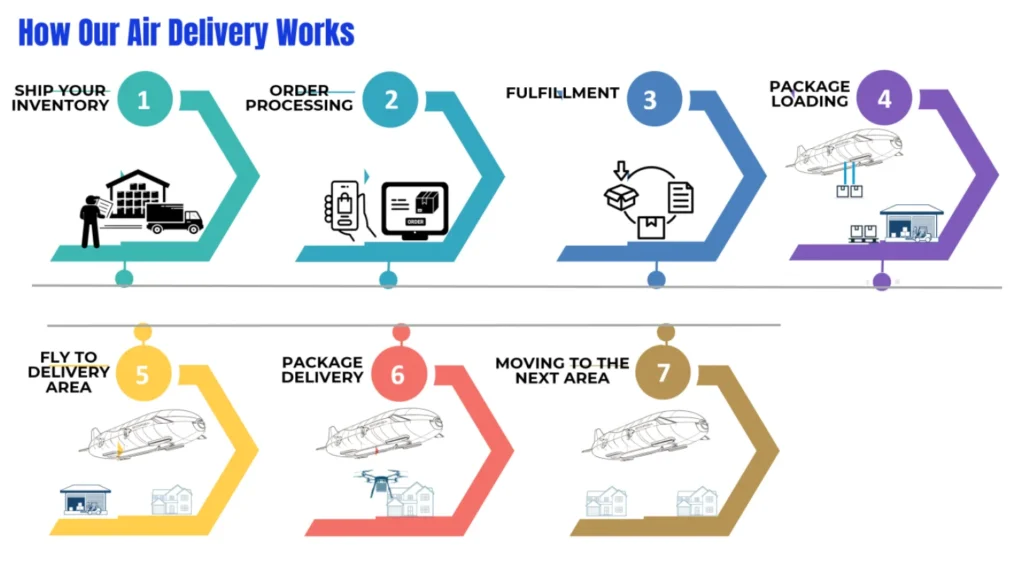
Major retailers such as Amazon and Walmart can optimize their logistics operations and meet consumer demand for faster shipping by facilitating rapid, cost-effective, and environmentally sustainable deliveries. Leveraging airborne fulfillment enables businesses to improve customer satisfaction, reduce operational costs, and enhance sustainability efforts.
According to recent market reports, the global last-mile delivery market is currently valued at around $160 billion and is projected to reach $300 billion or more by 2030. It is growing at a significant CAGR of 8-10%, driven by the booming e-commerce industry and increasing demand for fast deliveries.
In 2023, the United States delivered 21.7 billion packages, averaging 59 million packages per day—a number projected to increase. This surge underscores the pressing need for scalable and efficient last-mile solutions.
Traditional ground-based logistics suffer from congestion, high costs, and scalability limitations. In urban areas, delivery trucks spend up to 28% of their time idling in traffic, increasing fuel consumption and emissions. Furthermore, last-mile delivery accounts for nearly 53% of total shipping costs, making it the most expensive segment of the supply chain, and faces challenges related to environmental sustainability.
As online shopping continues to grow rapidly, traditional delivery methods are struggling to keep up with consumers’ evolving demands. Delivery companies are facing significant challenges due to traffic, parking issues, and the high volume of packages.
For more than a decade, Amazon and Walmart have been working to deliver packages straight to customers’ doorsteps, using drones instead of drivers. Drones operate individually, requiring separate flights for each package from a store or warehouse to the customer’s doorstep.
This approach is facing impossible-to-resolve Federal Aviation Administration (FAA) regulatory challenges; in addition, the cost per drone delivery is too high compared to traditional ground delivery, which prevents the deployment of drone delivery services in densely populated urban areas.
Walmart initially partnered with DroneUp to establish drone delivery hubs across multiple states. However, in early 2025, Walmart ended this partnership, citing high operational costs—approximately $30 per delivery (dbbnwa.com). The $30 for a single drone delivery is not economically viable. To achieve cost-effectiveness, the cost per delivery must be reduced to $1.50-$5 (uavcoach.com).
The FAA enforces stringent regulations on commercial drone operations, imposing severe restrictions, especially in urban environments, on BVLOS (Beyond Visual Line of Sight) operations.
The FAA Part 107 regulations govern the commercial use of drones for package delivery, including in highly populated urban areas. These FAA rules mandate that drones remain within the operator’s direct Visual Line of Sight (VLOS),
For conventional drones navigating the intricate airspace of cities and complex landscapes filled with buildings and other obstructions, the VLOS requirement is impossible to meet.
AFC complies with FAA regulations by designing its operations around the VLOS framework of Part 107. The airship serves as a hub for drone operations, and drone pilots on board maintain situational awareness and monitor drone flights in real time, enabling continuous visual tracking during launch, flight, delivery, and return, ensuring compliance with regulatory requirements. The airship itself functions as a mobile operations center, keeping drones within a defined airspace at all times.
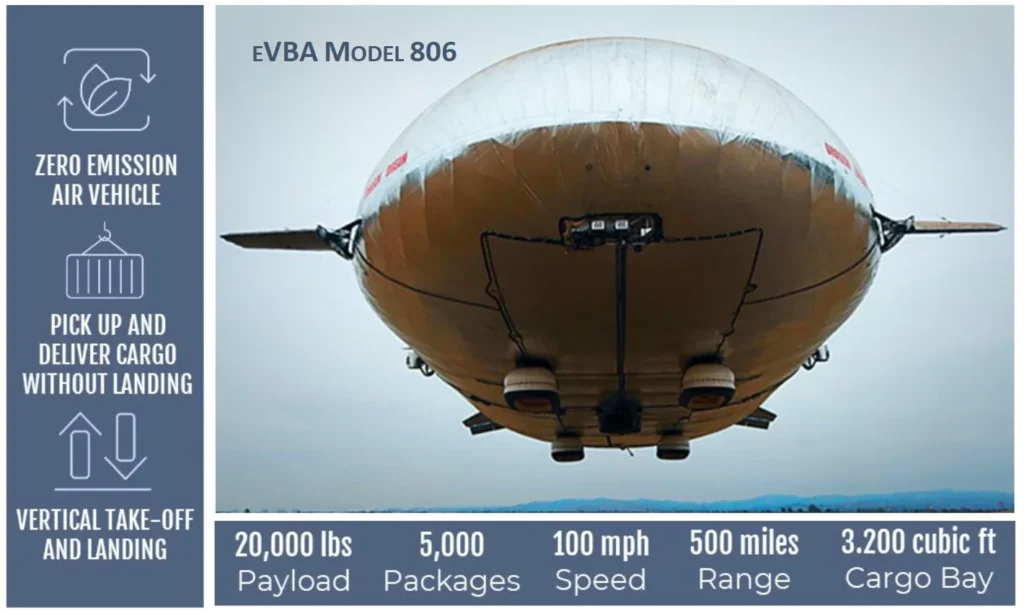
Economies of Scale —High Payload Capacity:
The eVBA can carry up to 5,000 packages at once, acting as a mobile distribution hub in the sky. Conventional drone operations have very limited payload capacity (typically 4-10 lbs per drone), meaning thousands of drones would be required to match the capacity of a single eVBA ML806.
The ML806 bundles hundreds of deliveries into a single aerial operation, eliminating the various cost factors associated with traditional drone delivery, including energy consumption, infrastructure, maintenance, and regulatory hurdles. This can reduce costs per delivery to $1.5, making it a highly scalable and profitable last-mile logistics solution.
Extended Operational Range:
Current technology limits drones’ battery life and range. Battery life constraints mean drones can only travel short distances before needing to be recharged, which limits efficiency due to short flight times (20-30 minutes per flight).
The eVBA ML806 has a long operational range and can hover over a delivery area for hours, reducing fuel and operational costs per package.
Elimination of Expensive Ground Infrastructure:
Conventional drone delivery requires extensive ground-based drone hubs, multiple recharging stations, and logistics centers, which add significant real estate and operational costs.
The eVBA can pick up a platform with preloaded packages without landing (hover mode) from the parking lot or the roof of the distribution center. No infrastructure is required at the distribution center to manage eVBAs. Packages will be stored and deployed directly from the airship, reducing handling, sorting, and land use costs.
Unlike traditional drone delivery systems that rely solely on ground-based operations, AFC eliminates the need for extensive ground infrastructure, reduces delivery costs, and enables ultra-fast deliveries in urban areas.
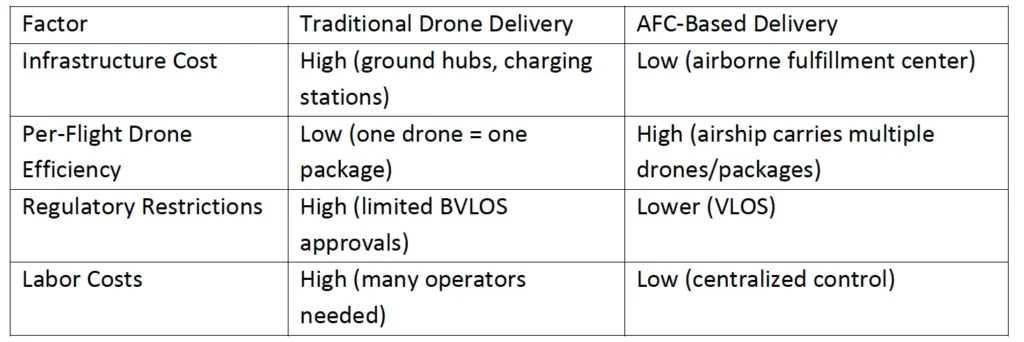
The 266 ft long eVBA Model ML806 full-scale preproduction prototype has been manufactured and tested in partnership with NASA, DARPA, and DoD.
The test confirmed that technology is ready to move forward with the advancement of commercial operations.
Last year, Aeros secured a Technical Assistance Memorandum from the FAA’s Unmanned Aircraft Systems (UAS) Integration Office. This ensures compliance with key aviation regulations and integration of AFC into the national airspace.
Commercial demonstration flights utilizing the Aeros Sky Dragon airship for select 3PL and online retail customers will begin in Southern California this year, providing package deliveries in a region notorious for traffic congestion and high e-commerce demand.
With zero-emission propulsion, automation-driven efficiency, and FAA-compliant operational models, the AFC system is set to revolutionize e-commerce fulfillment. The sky is no longer the limit—it’s the new frontier for last-mile delivery.
Aeros is currently running a “Testing the Waters” campaign to gauge investor interest in a planned Regulation A public offering. If you’d like to support our progress toward making this mission a reality, you can express your interest today.
Your indication of interest is non-binding but highly valuable, as it helps us demonstrate public interest while we prepare for our next phase of growth.
Thank you for being part of the Aeros vision and supporting the future of sustainable aviation.
This “testing the waters” communication is for informational purposes only and does not constitute an offer to sell or a solicitation of an offer to buy any securities. Aeros is currently “testing the waters” to gauge potential investor interest in a possible public securities offering under Regulation A Tier 2. No investment decisions should be made without reviewing the final offering statement, which will contain important information about the investment and its risks. The Securities and Exchange Commission has not approved or disapproved of these securities.
Disclaimer: (1) no funds or other consideration is being solicited, and if money is sent, it will not be accepted by the company; (2) no sales will be performed or commitments to purchase accepted until the offering statement is qualified and any such offer may be withdrawn or revoked, without obligation or commitment of any kind, at any time before notice of its acceptance given after the qualification date; and (3) a proposed purchaser’s indication of interest is non-binding and involves no obligation or commitment of any kind.

Founded in 1987, Aeros Corporation is a U.S.-based aerospace and defense company specializing in the design, certification, and production of advanced airships and aerostats. With a track record of successful collaborations with the U.S. Department of Defense, NASA, and DARPA, Aeros is pioneering next-generation solutions for global cargo transport, emergency response, and strategic logistics. For more information about Aeros, visit www.Aeroscraft.com.

